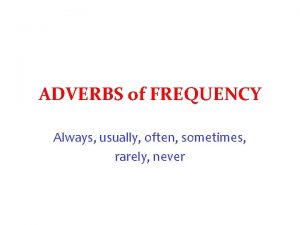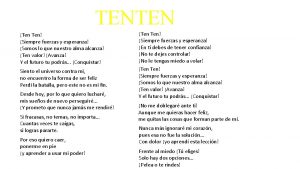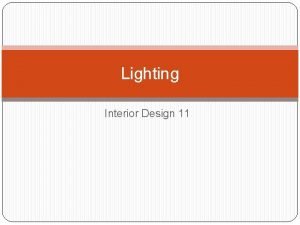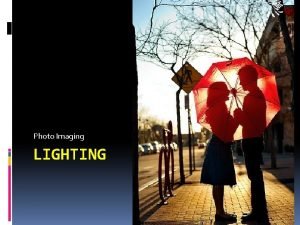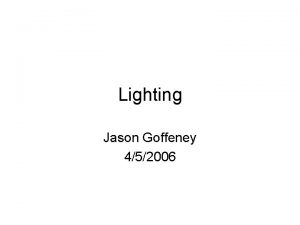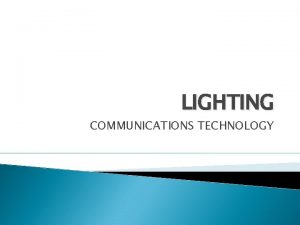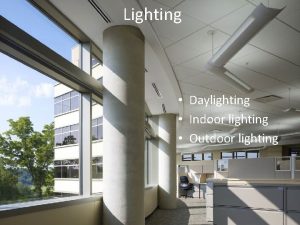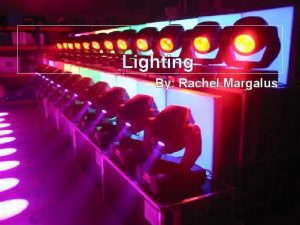LIGHTING CHAPTER TEN Lighting You can often achieve









- Slides: 9

LIGHTING CHAPTER TEN

Lighting You can often achieve all of your lighting controls by simply working with available light and simple reflectors and diffusers. Obviously the sun is the best natural light source, but at times this source is way to bright. For portraits, too much contrast is not flattering. Strong light, produces dark shadows under the eyes, makes lines and wrinkles more pronounced.

Lighting Diffusers: large piece of white cloth that serve to diffuse light, casting a very soft shadow. The best diffusers are the ones that collapse easily to become portable.

Lighting Reflector: Usually a piece of glass that gives you the ability to bounce light around your image. When working with a “silver” or “gold” reflector, one of the biggest issues is the reflector will bounce too much light onto your subject. Fix this by moving the reflector further away.

Lighting Collapsible reflectors are easy to carry and come in a variety of colors including white, silver, and gold. Big pieces of white card board, paper, or foamcore will work just as well for creating a white fill. Don’t forget you can always shoot INTO the sun. Position your subject with his or her back to the sun, which will cause a nice rim light, or halo.

Lighting Narrow Lighting: Turning the subject away from the main light source, and using the shadowy part as the main source of light. Broad Lighting: The subject is exposed to the main light source, not the shadowy part of the light source.

Flash Photography RANGE OF FLASH IS ABOUT 10 – 15 FEET. FILL: Uses the flash to fill in shadows. Typically used for backlit situations (shooting in bright light, but subject is in the shadows) RED EYE REDUCTION: Occurs when the light from your flash bounces off the retinas as he or she looks into the lens. This mode works by firing a flash, or the camera’s autofocus assist lamp, to close the subjects pupil. CANCEL: Simply deactivates the flash. Used when flash is not needed,

Flash Photography FLASH EXPOSURE COMPENSATION: A flash power adjustment control. Allowing you to increase or decrease the power of the flash. FLASH WHITE BALANCE: Ability to white balance with your flash. You will need to white balance with your flash because in many situations your flash is not the only light source in the room.

Flash Photography When shooting with a flash in a low lighting situation, everything outside of the zone of the subject will be underexposed (dark limbo space) If you are gunning for a quick shot, this will be your only option, but if you have more time you have two possibilities to improve your shot. 1. Higher ISO 2. Slow Sync Flash
 If you can imagine it you can achieve it
If you can imagine it you can achieve it If you think you can you can poem
If you think you can you can poem If you can't measure it quote
If you can't measure it quote If you cannot measure it you cannot manage it
If you cannot measure it you cannot manage it If you can't measure it you cannot improve it
If you can't measure it you cannot improve it Langfristiges fremdkapital
Langfristiges fremdkapital Always, usually often sometimes seldom rarely never
Always, usually often sometimes seldom rarely never It’s twenty past eight
It’s twenty past eight Ten ten siempre fuerzas y esperanza
Ten ten siempre fuerzas y esperanza Ten ten program
Ten ten program






